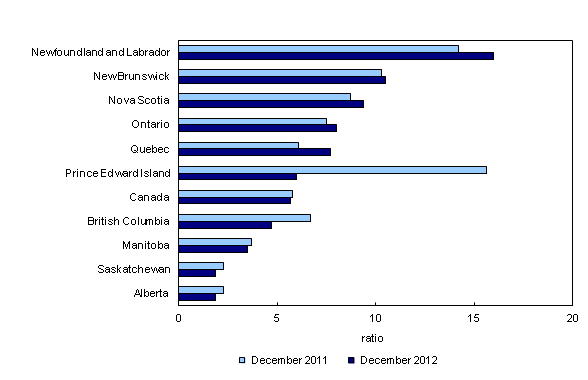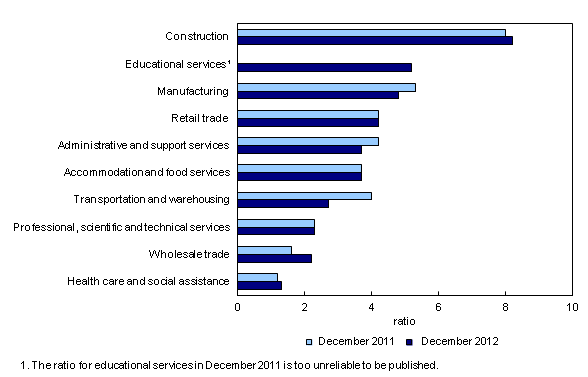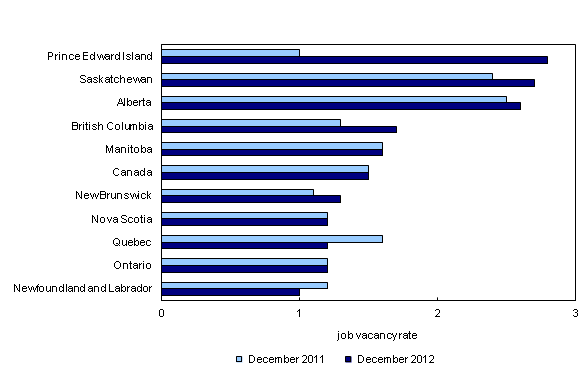Job vacancies, three-month average ending in December 2012
Archived Content
Information identified as archived is provided for reference, research or recordkeeping purposes. It is not subject to the Government of Canada Web Standards and has not been altered or updated since it was archived. Please "contact us" to request a format other than those available.
Released: 2013-03-20
Canadian businesses had 221,000 job vacancies in December, unchanged from December 2011. There were 5.7 unemployed people for every job vacancy, little changed from 5.8 in December 2011.
Ratio increases in Quebec, declines in some Western provinces
Provincially, Quebec was the lone province with a notable increase in the unemployment-to-job vacancies ratio. The ratio went from 6.1 unemployed people for every job vacancy in December 2011 to 7.7 in December 2012. The rise in the ratio was because the number of job vacancies in the province fell faster than the number of unemployed people.
The highest ratios of unemployed people to job vacancies continued to be among some of the Eastern provinces. In Newfoundland and Labrador, there were 16.0 unemployed people for every vacancy in December, followed by New Brunswick (10.5) and Nova Scotia (9.4). These figures were little changed from 12 months earlier.
The lowest ratios, in turn, were in the three Prairie provinces.
In Alberta, there were 1.9 unemployed people for every job vacancy, down from 2.3 in December 2011. The decline was largely a result of fewer unemployed people in the province. The ratio for Saskatchewan was also 1.9, and the ratio in Manitoba was 3.5.
In British Columbia, the ratio declined from 6.7 unemployed people for every job vacancy in December 2011 to 4.7 in December 2012. The decline was the result of more job vacancies, while at the same time, the number of unemployed people edged down.
In Prince Edward Island, the ratio fell over this 12-month period, from 15.6 unemployed people per job vacancy to 6.0. This was because of an increase in job vacancies from 600 to 1,600, while the number of unemployed people was unchanged (see "data quality" in the Note to readers).
In Ontario, there were 8.0 unemployed people for every job vacancy, little changed from 12 months earlier.
Ratio by sector
Sectoral analysis of the ratio of unemployed people to job vacancies is limited to those who last worked within the past 12 months, as unemployment data by sector are only available for these individuals.
Construction had the highest number of unemployed people for every vacancy among the large industrial sectors, at 8.2 in December, little changed from December 2011. Since unemployment patterns in this industry are seasonal, the ratio tends to be highest in the winter months and lowest in the summertime.
Manufacturing had a ratio of 4.8 unemployed people for every vacant job in December. There was little change in the ratio compared with 12 months earlier, but there were fewer unemployed people who had last worked in the sector over this period.
Wholesale trade was the only large industrial sector to show a sizeable increase in the ratio. In December, the ratio of unemployed people to job vacancies was 2.2, up from 1.6 in December 2011, mostly a result of fewer job vacancies.
The ratio in transportation and warehousing declined from 4.0 unemployed people for every job vacancy to 2.7 in December, all a result of more job vacancies.
Health care and social assistance had a ratio of 1.3 in December, the lowest of all industrial sectors. This ratio was little changed from 12 months earlier.
Among the smaller industrial sectors, one had a notable increase in the ratio while one sector had a decline. Mining, quarrying and oil and gas extraction saw its ratio rise from 1.6 in December 2011 to 2.7 in December 2012, as this sector had fewer job vacancies and more unemployed people.
Arts, entertainment and recreation had a decline in the ratio from 9.1 to 6.0 over the 12-month period, as the number of job vacancies increased.
Job vacancy rates
Data from this survey is also used to calculate the job vacancy rate. It is defined as the number of vacant positions divided by total labour demand, that is, occupied positions plus vacant positions. It corresponds to the share of jobs that are unfilled out of all payroll jobs available. Higher job vacancy rates are often associated with periods of economic growth, while lower rates may be associated with periods of slower growth or economic contraction.
In December, the national job vacancy rate among Canadian businesses was 1.5%, unchanged from 12 months earlier.
Provincially, the job vacancy rate increased in Prince Edward Island and British Columbia, declined in Quebec and Newfoundland and Labrador, and was little changed elsewhere.
In Prince Edward Island, the rate rose from 1.0% in December 2011 to 2.8% in December 2012. The job vacancy rate was 1.7% in British Columbia, up from 1.3% in December 2011.
In Quebec, the job vacancy rate declined from 1.6% to 1.2%, while in Newfoundland and Labrador, it decreased from 1.2% to 1.0%.
Job vacancy rates by sector
Arts, entertainment and recreation had 5,800 job vacancies and a job vacancy rate of 2.4% in December, up from 1.5% 12 months earlier. The information and culture sector also saw its rate increase, from 1.0% to 2.3%, with 7,600 job vacancies in December 2012.
The job vacancy rate in health care and social assistance was 2.1% in December, up from 1.7% a year earlier. The sector had 36,000 job vacancies in December.
Administrative and support services also had a rate of 2.1%, little changed from 12 months earlier, and there were 16,000 job vacancies.
The job vacancy rate in mining, quarrying and oil and gas extraction declined from 2.9% to 2.1% in the 12 months to December. There were 4,800 vacancies in this sector in December.
The lowest job vacancy rate was in educational services, at 0.4%, down from 1.0% 12 months earlier. In December 2012, there were 5,200 job vacancies in the sector.
Note to readers
Estimates of job vacancies are collected through the monthly Business Payrolls Survey (BPS). Starting with the January 2011 reference month, two questions were added to the BPS, which is the survey portion of the Survey of Employment, Payrolls and Hours (SEPH). These questions were: Did you have any vacant positions on the last business day of the month, and how many?
The target population is the same as that of the BPS and is comprised of all employers in Canada, except those primarily involved in: agriculture; fishing and trapping; private household services; religious organizations; the military personnel of the defense services; and federal, provincial and territorial public administration.
With each release, estimates for the current reference month are subject to revision. Estimates have been revised for the previous month. Users are encouraged to request and use the most up-to-date estimates for each month.
Data quality
Job vacancy and unemployment estimates are based on samples, and are therefore subject to sampling variability. Estimates for geographic areas and industries with smaller numbers of vacancies or smaller unemployed populations are subject to greater sampling variability.
Job vacancy, labour demand and unemployment estimates and their accompanying rates are not seasonally adjusted and should only be compared on a year-over-year basis. Given this is a new data series, trends are not yet available and therefore, data should be interpreted with caution.
All estimates are based on three-month moving averages. For example, estimates for the current month are based on an average of the estimates from the current month and the previous two months.
Definitions
Job vacancy/vacant position: A position is considered "vacant" if it meets all three of the following conditions: a specific position exists; work could start within 30 days; and the employer is actively seeking employees from outside the organization to fill the position.
Labour demand: Total labour demand is the sum of met (total payroll employment) and unmet (vacant positions) labour demand.
Largest industrial sectors: The sectors with the largest levels of payroll employment for which we have publishable job vacancy data.
Job vacancy rate: The number of vacant positions divided by total labour demand, that is, occupied positions plus vacant positions.
Unemployment-to-job vacancies ratios
All unemployed: The unemployment-to-job vacancies ratio for all unemployed is calculated by dividing the total number of unemployed, regardless of their previous work experience, using Labour Force Survey (LFS) data, by the number of vacant positions. This ratio reflects how many unemployed individuals are available for each vacant position and is a measure of the overall labour market tightness.
By sector: For each sector, the ratio is calculated by dividing the number of unemployed who last worked in that sector in the previous 12 months, using LFS data, by the number of vacant positions in the same sector. This excludes new entrants to the labour market as well as unemployed people who had not worked during the previous 12 months. Unemployment data by sector is known only for those who worked within the previous 12 months.
Use of estimates for the last sector worked does not imply that these unemployed individuals continued to look for work in that sector. This ratio reflects how many unemployed individuals who last worked in that sector are available for each vacant position in the sector. It is a measure of the labour market tightness within that sector.
Upcoming revisions
As part of the March 27, 2013 revisions to SEPH employment data, the next release of job vacancies data on April 16 may have very slight changes to some job vacancy rates, as SEPH is the source of filled positions. In addition, a revised job vacancies estimation method as well as some historical revisions to job vacancies data in certain jurisdictions and sectors will result in small changes to the number of job vacancies and their related rates and ratios. These small changes can be seen throughout the time series, from 2011 to present.
Job vacancy data tables are not currently available on CANSIM, but can be obtained by contacting us (toll-free 1-800-263-1136; infostats@statcan.gc.ca). Job vacancies data will be available on CANSIM, with the release of the data for January on April 16.
The next job vacancies release, for January, will be on April 16.
Contact information
For more information, contact us (toll-free 1-800-263-1136; infostats@statcan.gc.ca).
To enquire about the concepts, methods or data quality of this release, contact Jason Gilmore (613-951-7118; jason.gilmore@statcan.gc.ca), Labour Statistics Division.
- Date modified:




